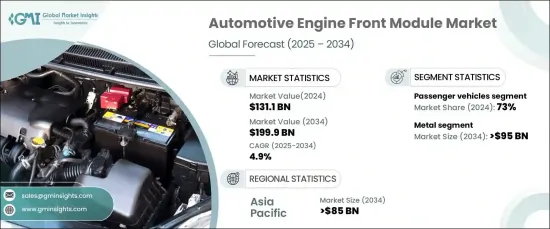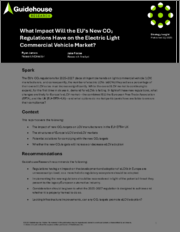
|
시장보고서
상품코드
1664906
자동차 엔진 프론트 모듈 시장 기회, 성장 촉진 요인, 산업 동향 분석, 예측(2025-2034년)Automotive Engine Front Module Market Opportunity, Growth Drivers, Industry Trend Analysis, and Forecast 2025 - 2034 |
||||||
자동차 엔진 프론트 모듈 세계 시장은 2024년에 1,311억 달러로 평가되었으며, 2025년부터 2034년까지 연평균 복합 성장률(CAGR) 4.9%로 성장할 것으로 예상됩니다.
이 성장의 주요 요인은 전기자동차(EV) 산업의 급속한 확대이며 배터리 및 중요 부품의 성능을 최적화하기위한 특수 열 관리 시스템이 필요합니다. 게다가 승용차와 상용차의 생산량이 증가하고 있는 것도, 최신의 자동차 설계에 있어서의 효율과 성능에 대한 요구의 고조를 반영해, 선진 프론트엔드 시스템 수요를 계속 끌어 올리고 있습니다.

세계의 도시화와 가처분 소득 증가는 특히 신흥 시장에서 승용차 판매를 촉진하고 있습니다. 이와 동시에 활황을 보이는 전자상거래와 물류 분야에서는 상용차 생산이 증가하고 있습니다. 이러한 추세는 자동차 산업의 진화하는 요구에 부응하는 견고하고 기술적으로 고급 엔진 전면 모듈에 대한 수요가 커지고 있습니다.
| 시장 범위 | |
|---|---|
| 시작연도 | 2024년 |
| 예측연도 | 2025년-2034년 |
| 시작금액 | 1,311억 달러 |
| 예측 금액 | 1,999억 달러 |
| CAGR | 4.9% |
시장은 복합재료, 금속, 플라스틱으로 구분되며, 2024년 시장 점유율은 금속이 45%로 압도적이었으며, 2034년까지 950억 달러의 수익을 창출할 것으로 예상됩니다. 철강과 알루미늄은 탁월한 내구성, 내열성 및 기계적 강도로 특히 선호됩니다. 알루미늄의 경량 특성은 연비를 향상시킬 뿐만 아니라 구조적인 무결성도 확보하고 지속가능성과 성능 향상을 목표로 하는 업계 동향에 부합하고 있습니다.
차량 유형별로는 승용차가 2024년 시장 점유율 73%를 차지했으며, 세계의 생산 및 판매 대수가 많음이 그 요인이 되고 있습니다. 도시화, 가처분 소득 증가, 개인 이동성에 대한 소비자 선호 증가 등의 요인이 수요를 가속화하고 있습니다. 게다가 경량 재료와 열 관리 기술의 진보에 의해 승용차 탑재가 진행되어, 연비 효율이나 전체적인 성능이 향상하고 있습니다.
아시아태평양의 자동차 엔진 전면 모듈 시장은 2024년에는 세계 점유율의 40%를 차지했고, 2034년에는 850억 달러를 창출할 것으로 예상됩니다. 중국은 자동차 제조와 소비 세계의 허브로서의 지위를 배경으로 이 기간 동안 350억 달러의 공헌이 예상되어 압도적인 존재감을 보여주고 있습니다. 이 지역에서는 전기자동차의 생산과 엄격한 연비 규제가 중시되고 있기 때문에 경량 재료의 채용이 더욱 진행되어 최첨단 엔진 전면 모듈 수요가 높아지고 있습니다.
결론적으로 자동차 엔진 프론트 모듈 시장은 전기자동차 기술의 진보, 경량 재료, 세계 자동차 생산량 증가에 힘입어 강력한 성장을 이루려고 합니다. 이러한 동향은 자동차 섹터의 진화하는 요구에 부응할 뿐만 아니라 효율, 성능, 지속가능성이라는 목표를 지원하고 있습니다.
목차
제1장 조사 방법과 조사 범위
- 조사 디자인
- 조사 접근
- 데이터 수집 방법
- 기본 추정과 계산
- 기준연도의 산출
- 시장추계의 주요 동향
- 예측 모델
- 1차 조사와 검증
- 1차 소스
- 데이터 마이닝 소스
- 시장 정의
제2장 주요 요약
제3장 업계 인사이트
- 업계 생태계 분석
- 공급자의 상황
- 원재료 공급자
- 부품 제조업체
- 모듈 조립 제조업체
- Tier 1 공급업체
- OEM(상대처 브랜드 제조)
- 이익률 분석
- 코스트 내역 분석
- 기술과 혁신의 전망
- 주요 뉴스와 대처
- 규제 상황
- 영향요인
- 성장 촉진요인
- 가볍고 지속 가능한 재료에 대한 수요 증가
- EV 시장의 급속한 확대
- 스마트 센서, 액티브 그릴 셔터, 모듈 설계의 기술 통합
- 승용차 및 상용차 생산의 성장
- 충돌 안전성과 내구성의 중시
- 업계의 잠재적 리스크 및 과제
- 높은 초기 투자 비용
- 복잡한 공급망
- 성장 촉진요인
- 성장 가능성 분석
- Porter's Five Forces 분석
- PESTEL 분석
제4장 경쟁 구도
- 소개
- 기업의 시장 점유율 분석
- 경쟁 포지셔닝 매트릭스
- 전략 전망 매트릭스
제5장 시장 추정 및 예측 : 구성 요소별, 2021년-2034년
- 주요 동향
- 라디에이터
- 냉각팬
- 에어컨 커패시터
- 헤드라이트 및 그릴
- 기타
제6장 시장 추정 및 예측 : 차량별, 2021년-2034년
- 주요 동향
- 승용차
- 해치백
- 세단
- SUV차
- 상용차
- 소형 상용차(LCV)
- 대형 상용차(HCV)
제7장 시장 추정 및 예측 : 재료별, 2021년-2034년
- 주요 동향
- 금속
- 복합재료
- 플라스틱
제8장 시장 추정 및 예측 : 판매 채널별, 2021년-2034년
- 주요 동향
- OEM
- 애프터마켓
제9장 시장 추정 및 예측 : 지역별, 2021년-2034년
- 주요 동향
- 북미
- 미국
- 캐나다
- 유럽
- 영국
- 독일
- 프랑스
- 스페인
- 이탈리아
- 러시아
- 북유럽
- 아시아태평양
- 중국
- 인도
- 일본
- 한국
- 뉴질랜드
- 동남아시아
- 라틴아메리카
- 브라질
- 멕시코
- 아르헨티나
- 중동 및 아프리카
- UAE
- 남아프리카
- 사우디아라비아
제10장 기업 프로파일
- Aisin Seiki
- Calsonic Kansei
- Denso
- Eberspächer
- Faurecia
- Grupo Antolin
- HBPO
- Hella
- HYUNDAI Mobis
- Magna
- Magneti Marelli
- Mahle GmbH
- Mitsui Mining &Smelting Co
- Plastic Omnium
- Robert Bosch
- SAS Automotive Systems
- SL
- Sumitomo Riko
- Tata AutoComp Systems
- Valeo
The Global Automotive Engine Front Module Market was valued at USD 131.1 billion in 2024 and is projected to grow at a CAGR of 4.9% from 2025 to 2034. This growth is largely fueled by the rapid expansion of the electric vehicle (EV) industry, which demands specialized thermal management systems to optimize battery and critical component performance. Additionally, the increasing production of passenger and commercial vehicles continues to drive demand for advanced front-end systems, reflecting the growing need for efficiency and performance in modern automotive design.

Global urbanization and rising disposable incomes are propelling passenger car sales, especially in emerging markets. Simultaneously, the booming e-commerce and logistics sectors are increasing commercial vehicle production. These trends are creating significant demand for robust, technologically advanced engine front modules that meet the evolving needs of the automotive industry.
| Market Scope | |
|---|---|
| Start Year | 2024 |
| Forecast Year | 2025-2034 |
| Start Value | $131.1 Billion |
| Forecast Value | $199.9 Billion |
| CAGR | 4.9% |
The market is segmented into composites, metal, and plastics, with metals dominating in 2024 at a 45% market share, generating USD 95 billion by 2034. Steel and aluminum are particularly favored due to their exceptional durability, heat resistance, and mechanical strength. Aluminum's lightweight properties not only enhance fuel efficiency but also ensure structural integrity, aligning with industry trends for improved sustainability and performance.
In terms of vehicle type, passenger vehicles commanded a 73% market share in 2024, driven by their high production and sales volumes worldwide. Factors such as urbanization, increasing disposable incomes, and growing consumer preferences for personal mobility are accelerating demand. Moreover, advancements in lightweight materials and thermal management technologies are being increasingly integrated into passenger vehicles, boosting their fuel efficiency and overall performance.
The Asia Pacific automotive engine front module market captured 40% of the global share in 2024, with projections to generate USD 85 billion by 2034. China stands out as a dominant force, expected to contribute USD 35 billion during this period, owing to its position as a global hub for automotive manufacturing and consumption. The region's emphasis on electric vehicle production and strict fuel efficiency regulations is further driving the adoption of lightweight materials, enhancing demand for cutting-edge engine front modules.
In conclusion, the automotive engine front module market is poised for robust growth, underpinned by advancements in EV technology, lightweight materials, and rising global vehicle production. These trends not only cater to the evolving needs of the automotive sector but also support its goals of efficiency, performance, and sustainability.
Table of Contents
Chapter 1 Methodology & Scope
- 1.1 Research design
- 1.1.1 Research approach
- 1.1.2 Data collection methods
- 1.2 Base estimates and calculations
- 1.2.1 Base year calculation
- 1.2.2 Key trends for market estimates
- 1.3 Forecast model
- 1.4 Primary research & validation
- 1.4.1 Primary sources
- 1.4.2 Data mining sources
- 1.5 Market definition
Chapter 2 Executive Summary
- 2.1 Industry 3600 synopsis, 2021 - 2034
Chapter 3 Industry Insights
- 3.1 Industry ecosystem analysis
- 3.2 Supplier landscape
- 3.2.1 Raw material suppliers
- 3.2.2 Component manufacturers
- 3.2.3 Module assemblers
- 3.2.4 Tier-1 suppliers
- 3.2.5 OEMs (Original Equipment Manufacturers)
- 3.3 Profit margin analysis
- 3.4 Cost breakdown analysis
- 3.5 Technology & innovation landscape
- 3.6 Key news & initiatives
- 3.7 Regulatory landscape
- 3.8 Impact forces
- 3.8.1 Growth drivers
- 3.8.1.1 Rising demand for lightweight and sustainable materials
- 3.8.1.2 The rapid expansion of the EV market
- 3.8.1.3 Technological integration of smart sensors, active grille shutters, and modular designs
- 3.8.1.4 Growth in passenger car and commercial vehicle production
- 3.8.1.5 Focus on crash safety and durability
- 3.8.2 Industry pitfalls & challenges
- 3.8.2.1 High initial investment costs
- 3.8.2.2 Complex supply chain
- 3.8.1 Growth drivers
- 3.9 Growth potential analysis
- 3.10 Porter’s analysis
- 3.11 PESTEL analysis
Chapter 4 Competitive Landscape, 2024
- 4.1 Introduction
- 4.2 Company market share analysis
- 4.3 Competitive positioning matrix
- 4.4 Strategic outlook matrix
Chapter 5 Market Estimates & Forecast, By Component, 2021 - 2034 ($Bn, Units)
- 5.1 Key trends
- 5.2 Radiator
- 5.3 Cooling fan
- 5.4 Air conditioning condenser
- 5.5 Headlights and grilles
- 5.6 Others
Chapter 6 Market Estimates & Forecast, By Vehicle, 2021 - 2034 ($Bn, Units)
- 6.1 Key trends
- 6.2 Passenger vehicles
- 6.2.1 Hatchback
- 6.2.2 Sedan
- 6.2.3 SUV
- 6.3 Commercial vehicles
- 6.3.1 Light Commercial Vehicles (LCV)
- 6.3.2 Heavy Commercial Vehicles (HCV)
Chapter 7 Market Estimates & Forecast, By Material, 2021 - 2034 ($Bn, Units)
- 7.1 Key trends
- 7.2 Metal
- 7.3 Composites
- 7.4 Plastics
Chapter 8 Market Estimates & Forecast, By Sales Channel, 2021 - 2034 ($Bn, Units)
- 8.1 Key trends
- 8.2 OEM
- 8.3 Aftermarket
Chapter 9 Market Estimates & Forecast, By Region, 2021 - 2034 ($Bn, Units)
- 9.1 Key trends
- 9.2 North America
- 9.2.1 U.S.
- 9.2.2 Canada
- 9.3 Europe
- 9.3.1 UK
- 9.3.2 Germany
- 9.3.3 France
- 9.3.4 Spain
- 9.3.5 Italy
- 9.3.6 Russia
- 9.3.7 Nordics
- 9.4 Asia Pacific
- 9.4.1 China
- 9.4.2 India
- 9.4.3 Japan
- 9.4.4 South Korea
- 9.4.5 ANZ
- 9.4.6 Southeast Asia
- 9.5 Latin America
- 9.5.1 Brazil
- 9.5.2 Mexico
- 9.5.3 Argentina
- 9.6 MEA
- 9.6.1 UAE
- 9.6.2 South Africa
- 9.6.3 Saudi Arabia
Chapter 10 Company Profiles
- 10.1 Aisin Seiki
- 10.2 Calsonic Kansei
- 10.3 Denso
- 10.4 Eberspächer
- 10.5 Faurecia
- 10.6 Grupo Antolin
- 10.7 HBPO
- 10.8 Hella
- 10.9 HYUNDAI Mobis
- 10.10 Magna
- 10.11 Magneti Marelli
- 10.12 Mahle GmbH
- 10.13 Mitsui Mining & Smelting Co
- 10.14 Plastic Omnium
- 10.15 Robert Bosch
- 10.16 SAS Automotive Systems
- 10.17 SL
- 10.18 Sumitomo Riko
- 10.19 Tata AutoComp Systems
- 10.20 Valeo



















